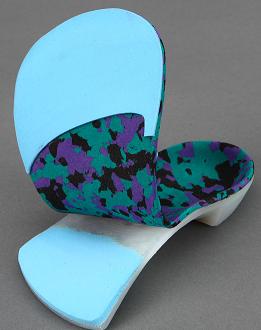A number of recent studies (1-7) have shown how foot orthotics should be made to best relieve pain under the balls of the feet. Unfortunately, many people with metatarsalgia, neuroma, callus, sesamoiditis or other causes of ball of foot pain have received orthotics that do not work as well as they should. This page will explain how orthotics for ball of foot pain should be made so that you can get the best possible relief of your pain.
Video: How Orthotics Should be Made to Relieve Ball of Foot Pain Including Neuroma
How Must Orthotics Be Made to Relieve Ball of Foot Pain?
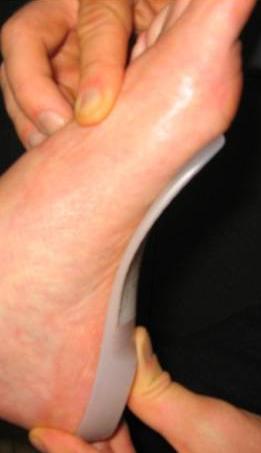
Orthotic should hug the arch of the foot tightly
Studies show that the most important aspect of the orthotic is that it conform extremely tight to the arch of your foot. By conforming close to the arch it is able to transfer pressure off of the ball of your foot. These are called “total contact orthotics”.In addition, orthotics for ball of foot pain should include cushion under the ball of the foot. Figure 1 shows an orthotic conforming very close to the arch of the foot.
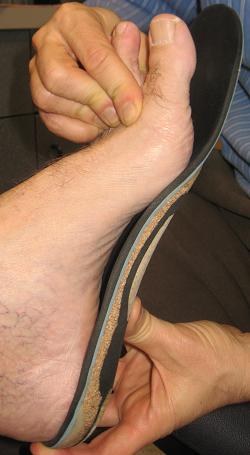
Orthotic gapping from arch.
Why do Many Orthotics Not Work to Treat Pain under the Balls of the Feet?
Many orthotics do not work well to relieve pain under the ball of the foot because they are made with an arch that is too low and doesn’t hug the arch of the foot tight enough. When this occurs the orthotic is not able to effectively transfer pressure off of the ball of the foot. Figure 2 shows an orthotic that does not conform close enough to the arch.
The importance of total contact orthotics has been demonstrated in several well done studies. In particular, a 2006 study done at George Washington University showed that very tight contour with the arch reduces pressure on the ball of the foot (2).
In addition, specific types of cushion has been shown to be important to reduce force under the ball of the foot and help eliminate ball of foot pain. Figure 3 shows an orthotic with cushion under the ball of the foot and also extra cushion on top of the orthotic which will act to decrease pressure on the ball of the foot.
If you need orthotics to treat ball of foot pain, you want to be absolutely sure that they are made correctly, conform air tight to your arch and are prescribed with appropriate cushion. If you are in the Seattle area, make an appointment for an orthotic evaluation.
Keys to Making Proper Ball of Foot Pain Orthotic:
- The cast of your foot that is used to make the orthotics must be a non-weightbearing cast or laser scan. If the foot bears weight while the cast is taken, the resultant orthotic has a flatter arch and is less effective at transferring pressure off of the ball of the foot. Learn more here about how your foot should be casted for orthotics
- Your doctor MUST place your foot in the correct position when casting. Casting can be done with plaster or a laser scan. It is imperative that that the podiatrist him/herself takes the cast of your foot. Taking a proper cast is critical and if a medical assistant do takes your cast instead of the doctor, you should go to a different podiarist. Proper casting is critical to a good outcome and takes a long time to learn to do properly.
- The podiatrist must write an orthotic prescription that tells the orthotic lab to make the orthotic in a way that the arch of the orthotic is nearly airtight to the arch of the foot. If your doctor’s prescription does not say this specifically, the orthotic will likely gap from the foot and not do a good job at transferring pressure off of the ball off of the balls of your feet.
- The doctor must use a very high quality orthotic lab. There is a lot of variability in the quality of orthotics. Many orthotics are made with arches that are too low in order to prevent any possibility of the patient complaining about the orthotic irritating their arch. Arch irritation does sometimes occur with total contact orthotics, but a good podiatrist will be able to easily adjust the orthotics. If they can’t, you need a podiatrist who has more expertise in orthotic therapy.
Does Everyone with Ball of Foot Pain Need Custom Orthotics?
Not at all. In fact, we often recommend starting treatment with over-the-counter arch supports. OTC arch supports do not, however, conform as close to your arch as well-made custom orthotics so they will not transfer as much pressure off of the balls of the feet. Like custom orthotics, prefabricated ones work best for neuromas and other causes of ball of foot pain if they have a higher arch.
We list the a complete home treatment plan for ball of foot pain here.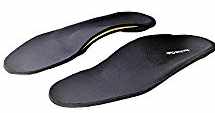
Our favorite OTC arch support for ball of foot pain to wear in athletic or walking shoes is the FootChair Medical Grade Arch Support. It’s relatively high and firm arch and the unique feature of an easily adjustable arch height make for the most effective prefabricated orthotic at reducing pressure under the balls of the feet.
Our recommended orthotic for smaller shoes including high heels, flats and soccer cleats is also from FootChair. This is the FootChair 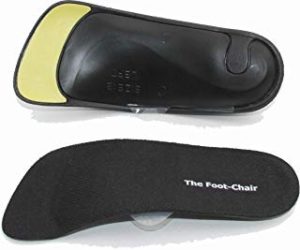 Slim Orthotic. This device has the same great adjustable arch but in a much slimmer profile. It also flexes to adapt to different heel heights.
Slim Orthotic. This device has the same great adjustable arch but in a much slimmer profile. It also flexes to adapt to different heel heights.
Why Are So Many Ball of Foot Pain Orthotics Not Made Correctly?
Sadly, orthotic therapy is not as well regulated as it should be. Many doctors who provide orthotics are not as well trained as they should be in orthotic therapy. In addition, many have not kept up with the latest research on orthotic therapy.
If you have pain under the balls of your feet and would like to have an evaluation, make an appointment to see us in our Seattle foot and ankle clinic. If you already have orthotics, bring them with you so we can evaluate them.
References for Ball of Foot Pain Orthotics
- Chalmers AC, Busby C, Goyert J, et al. Metatarsalgia and rheumatoid arthritis-a randomized, single blind, sequential trial comparing two types of foot orthoses and supportive shoes. J Rheumat 27(7):1643-7, 2000.
- Mueller M. Efficacy and Mechanism of Orthotic Devices to Unload Metatarsal Heads in People With Diabetes and a History of Plantar Ulcers. Physical Therapy June 2006 vol. 86 no. 6 833-842
- Chang AH, Abu-Faraj ZU, Harris GF, et al: Multistep measurement of plantar pressure alterations using metatarsal pads. Foot Ankle Int. 15:654-60, 1994.
- Holmes GB, Timmerman MD: A quantitative assessment of the effect of metatarsal pads on plantar pressures. Foot Ankle. 11:141-145, 1990.
- Hsi WL, Kang JH, Lee X: Optimum position of metatarsal pad in metatarsalgia for pressure relief. Am J Phys Med Rehabil. 84:514-520, 2005.
- Kang JH, Chen MD, Chen SC, et al: Correlations between subjective treatment responses and plantar pressure parameters of metatarsal pad treatment in metatarsalgia patients: a prospective study. BMC Musculo Skele Disord. 7:95-102, 2006.
- Kelly A, Winson I: Use of ready-made insoles in the treatment of lesser metatarsalgia: a prospective randomized controlled trial. Foot Ankle Int. 19: 217-20, 1998.
- Pawelka S, Kopf A, Zwick E, et al: Comparison of two insole materials using subjective parameters and pedobarography (pedar-system). Clin Biomech. 12:S6-S7, 1997.
- Postema K, Burm PE, Zande ME, et al: Primary metatarsalgia -the influence of a custom moulded insole and a rockerbar on plantar pressure. Prosthet Orthot Int. 22:35-44, 1998.





